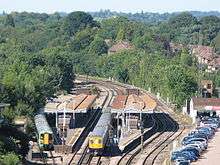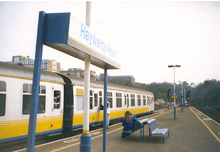Haywards Heath railway station
Haywards Heath railway station is on the Brighton Main Line in England, serving the town of Haywards Heath, West Sussex. It is 37 miles 59 chains (60.7 km) down the line from London Bridge via Redhill and is situated between Balcombe and Wivelsfield. It is managed by Southern.
| Haywards Heath | |
|---|---|
 | |
| Location | |
| Place | Haywards Heath |
| Local authority | District of Mid Sussex |
| Grid reference | TQ330245 |
| Operations | |
| Station code | HHE |
| Managed by | Southern |
| Number of platforms | 4 |
| DfT category | B |
| Live arrivals/departures, station information and onward connections from National Rail Enquiries | |
| Annual rail passenger usage* | |
| 2014/15 | |
| 2015/16 | |
| 2016/17 | |
| 2017/18 | |
| – Interchange | |
| 2018/19 | |
| – Interchange | |
| History | |
| 12 July 1841 | Opened (terminus) |
| 21 September 1841 | Opened (through) |
| 1883 [1] | Ardingly branch opened |
| 1933 | Electrification and Rebuilt |
| 28 October 1963 [1] | Ardingly branch closed |
| National Rail – UK railway stations | |
| |
Trains calling at Haywards Heath are operated by Southern and Thameslink. Until 2008 a small number of CrossCountry services also stopped here.[2]
History



The London and Brighton Railway opened its main line from a junction with the London and Croydon Railway at Norwood as far as Haywards Heath on 12 July 1841, a coach service was provided to take passengers on the remainder of their journey towards Brighton. The remainder of the line to Brighton opened shortly after on 21 September of the same year. The original station was designed by the architect David Mocatta and included a central passing line, and an awning over the platform.[3] The station retained its importance as a junction following the construction of the line to Lewes from Keymer 3 miles (4.8 km) to the south. From 1846 the railway became the London Brighton and South Coast Railway.
On 3 September 1883 the Lewes and East Grinstead Railway opened a branch line from Copyhold Junction, just north of the station, to Horsted Keynes railway station on their existing line between those towns.[4] There was an intermediate station at Ardingly.[1] As a result, Haywards Heath station was enlarged by the provision of two bay platforms. As soon as the line was opened, the Lewes and East Grinstead Railway merged with the London Brighton and South Coast Railway, but until 1912, there was no physical connection between the tracks of the branch line and those of the main line; they ran parallel all the way to Haywards Heath station.[5] Once the connection was made, it provided a relief route for the congested Brighton main line from Croydon to Brighton via Oxted, East Grinstead and Haywards Heath. This double-track branch line was closed to passengers on 28 October 1963, but a single-track section remains to serve a freight and aggregates terminal at Ardingly.[1]
Haywards Heath station was the site of the first use of the practice of "slipping" coaches from the rear of express trains, at intermediate junctions, for onward transmission to smaller stations. The earliest recorded example was in February 1858, when coaches for Hastings were slipped from a London Bridge to Brighton express.[6] This practice was a regular feature at the station until the electrification of the line during 1932/3. The station and surrounding structures such as bridges were also totally rebuilt at this time. A single signal box, alongside Platform 4 (the westernmost platform face), replaced the former North and South boxes.
In 2014, work began on a new "Station Quarter", which would include construction of a new multi-storey car park and footbridge to service the platforms, a new Waitrose supermarket on site and a regeneration of the existing station buildings.[7] The multi-storey car park was opened in late 2016 along with the new footbridge, while the new Waitrose supermarket was opened in March 2017.[8]
Layout
The station lies on a quadruple-track[lower-alpha 1] passing loop (the line either side of the station is double-track), which allows fast services to overtake stopping services. As such, it has a total of four platforms, one per track, numbered 1 to 4.[9]
- Platforms 1 and 2 are used for southbound services to destinations such as Brighton, Littlehampton, Eastbourne and Hastings. Non-stop services usually pass through platform 2.
- Platforms 3 and 4 are used for northbound services towards London and beyond. Non-stop services typically run through platform 3.
Unusually, the platforms have been numbered "right-to-left" (when facing London), instead of "left-to-right" which is the usual numbering scheme on the Brighton Main Line.
Platforms 1 and 4 are signalled bidirectionally, which allows trains to reverse here or run "the wrong way" through the station at times of disruption. Platforms 2 and 3 are partially signalled in both directions, allowing trains running to/from the south to reverse here.[10][11]
Access
There are three entrances/exits at the station. The main one is just off Commercial Square; access to platforms is in the form of a subway under the railway line. The other two entrances and exits use the new footbridge on the southern end of the platforms; one end of the footbridge leads onto Market Place and the other end connects with the station car park at Clair Road. All routes in and out of the station offer step-free access.
Services
The typical Monday-Saturday service from the station is:
Northbound
- 4tph (trains per hour) to London Victoria
- 2tph to Bedford via St Pancras International
- 2tph to Cambridge via St Pancras International and Stevenage.
Southbound
- 6tph to Brighton via Burgess Hill
- 2tph to Eastbourne, one of which continues to Ore
- 2tph to Littlehampton via Hove and Worthing
Trains to Littlehampton and to Eastbourne (or Ore) run together between London and Haywards Heath, where they divide.
On Sundays the services to Cambridge do not run, while southbound services are reduced in frequency to 4tph to Brighton, 1tph to Littlehampton and 1tph to Ore. Sunday services to Ore and Littlehampton run separately and do not divide here.
Freight sidings
The freight sidings at Haywards Heath were constructed during the First World War when the railway received a rapid growth in its freight traffic as a result of munitions trains travelling to Newhaven. They were intended to enable passenger trains to overtake slower freight traffic.
Today a sidings track does remain from Old Wickham Lane Bridge, 700 meters north of the station to Folly Hill Tunnel entrance. This line is not often used anymore, however it is protected for future extension to the Bluebell Railway. An area imminently east of platform 1 is also protected for the potential terminus platform / station for the Bluebell if it does reach Haywards Heath.[12] The new terminus would have a maximum of 1 platform, but would not be numbered platform 0.
Folly Hill tunnel

Just south of the station there is a 249-yard (228.6 m) tunnel through Folly Hill. There was an accident during the construction of this tunnel on 2 January 1841, causing a roof fall and killing three men, which prevented the railway from opening through to Brighton in the July.[13] Until the 1970s this tunnel suffered from an excess of water falling from the ground above and in the 1840s it had to be lined with galvanised iron sheeting to prevent the water from falling on the third class passengers in open carriages.[14]
Notes
- There is also a fifth track through the station, however it is unelectrified and rarely used; it is located next to platform 1.
References
- Ardingly railway station on Disused-Stations.org.uk - Nick Catford - Accessed 9 September 2007
- "Crosscountry Trains FAQ - Timetable Change". Archived from the original on 17 December 2007. Retrieved 13 January 2008.
- Turner, John Howard (1977). The London Brighton and South Coast Railway 1 Origins and Formation. Batsford. ISBN 0-7134-0275-X. pp.126-38.
- Turner, John Howard (1979). The London Brighton and South Coast Railway 3 Completion and Maturity. Batsford. ISBN 0-7134-1389-1. pp.23-34.
- Mitchell, Vic and Smith, Keith (1986). Southern Main Lines - Three Bridges to Brighton. Middleton Press. ISBN 0-906520-35-5
- Ellis, C. Hamilton (1970). The London Brighton and South Coast Railway. Ian Allan. pp. 98–9.
- "Haywards Heath Station Information - Southern Railway". www.southernrailway.com.
- "New Waitrose store opens in Haywards Heath". www.midsussextimes.co.uk. Retrieved 28 January 2018.
- "Station facilities for Haywards Heath". www.nationalrail.co.uk.
- "Three Bridges to Brighton on YouTube
- "Brighton to Gatwick (Airport)" on YouTube
- "Bluebell Railway Plans Haywards Heath" (PDF). 194.165.12.101. Retrieved 29 December 2018.
- Gray, Adrian (1978). The London to Brighton Line 1841-1977. Oakwood Press. p. 119.
- Turner, John Howard (1977). The London Brighton and South Coast Railway 1 Origins and Formation. Batsford. ISBN 0-7134-0275-X. p.142.
External links
- Train times and station information for Haywards Heath railway station from National Rail
| Preceding station | Following station | |||
|---|---|---|---|---|
| Gatwick Airport | Southern Mainline West |
Burgess Hill or Preston Park or Hove | ||
| Gatwick Airport | Southern Mainline East |
Wivelsfield or Plumpton or Lewes | ||
| Gatwick Airport | Southern Brighton Main Line |
Burgess Hill | ||
| Three Bridges or Balcombe |
Thameslink Thameslink |
Wivelsfield or Burgess Hill | ||
| Gatwick Airport | Gatwick Express Gatwick Express Peak hours only |
Hassocks | ||
| Disused railways | ||||
| Ardingly Line and station closed |
London, Brighton and South Coast Railway Lewes and East Grinstead Railway |
Terminus | ||